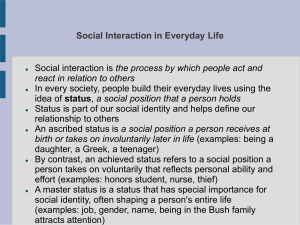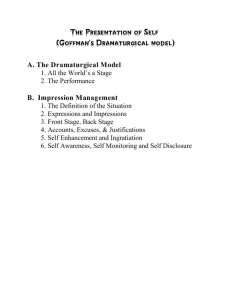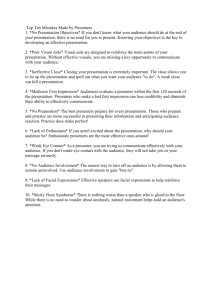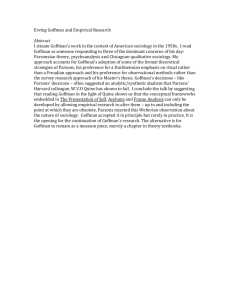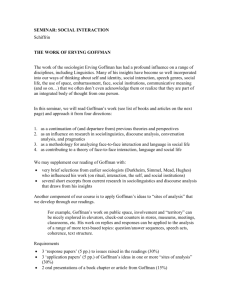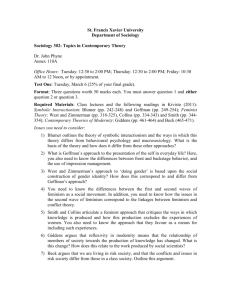File - sociology 101
advertisement
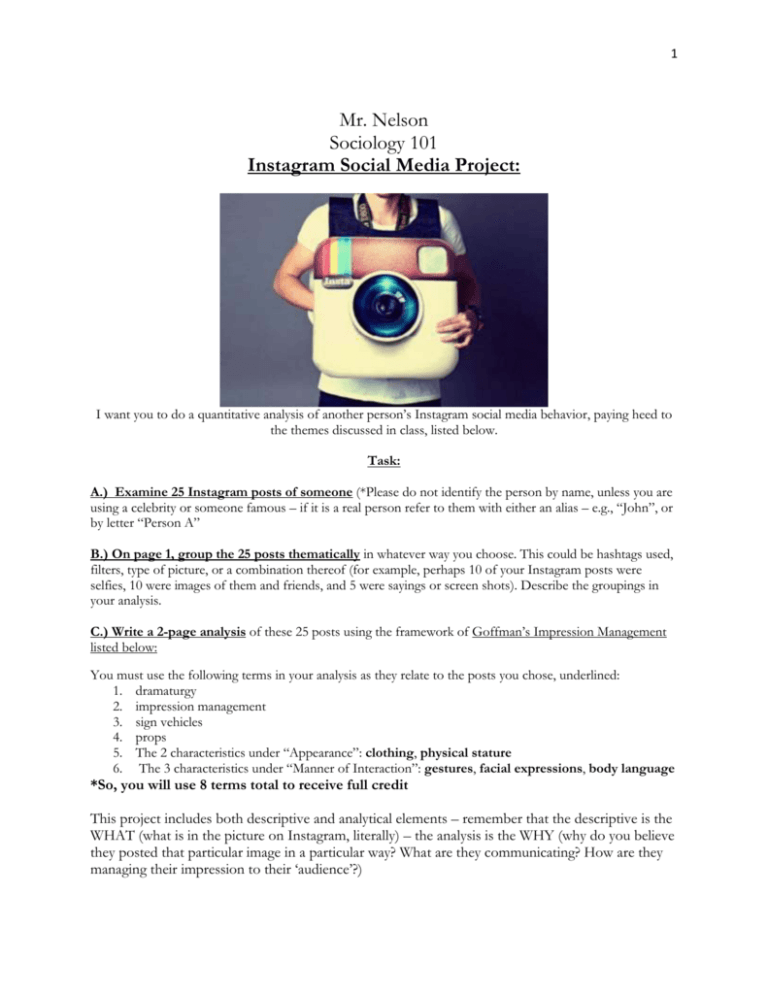
1 Mr. Nelson Sociology 101 Instagram Social Media Project: I want you to do a quantitative analysis of another person’s Instagram social media behavior, paying heed to the themes discussed in class, listed below. Task: A.) Examine 25 Instagram posts of someone (*Please do not identify the person by name, unless you are using a celebrity or someone famous – if it is a real person refer to them with either an alias – e.g., “John”, or by letter “Person A” B.) On page 1, group the 25 posts thematically in whatever way you choose. This could be hashtags used, filters, type of picture, or a combination thereof (for example, perhaps 10 of your Instagram posts were selfies, 10 were images of them and friends, and 5 were sayings or screen shots). Describe the groupings in your analysis. C.) Write a 2-page analysis of these 25 posts using the framework of Goffman’s Impression Management listed below: You must use the following terms in your analysis as they relate to the posts you chose, underlined: 1. dramaturgy 2. impression management 3. sign vehicles 4. props 5. The 2 characteristics under “Appearance”: clothing, physical stature 6. The 3 characteristics under “Manner of Interaction”: gestures, facial expressions, body language *So, you will use 8 terms total to receive full credit This project includes both descriptive and analytical elements – remember that the descriptive is the WHAT (what is in the picture on Instagram, literally) – the analysis is the WHY (why do you believe they posted that particular image in a particular way? What are they communicating? How are they managing their impression to their ‘audience’?) 2 Notes to help you: Sociologist Erving Goffman developed the concept of dramaturgy, the idea that life is like a never-ending play in which people are actors. Goffman believed that when we are born, we are thrust onto a stage called everyday life, and that our socialization consists of learning how to play our assigned roles from other people. We enact our roles in the company of others, who are in turn enacting their roles in interaction with us. He believed that whatever we do, we are playing out some role on the stage of life. Impression Management Goffman coined the term impression management to refer to our desire to manipulate others’ impressions of us on the front stage. According to Goffman, we use various mechanisms, called sign vehicles, to present ourselves to others. The most commonly employed sign vehicles are the following: 1. Social setting 2. Appearance 3. Manner of interacting 1. Social Setting The social setting is the physical place where interaction occurs. It could be a doctor’s examination room, a hallway, someone’s home, or a professor’s office. How we arrange our spaces, and what we put in them, conveys a lot of information about us. A person who lives in a huge home with security guards, attack dogs, and motion detectors conveys the message that he or she is very important, wealthy, and powerful, and probably that uninvited visitors should stay away. On the other hand, the owner of a house with no fence, lots of lights, and a welcome mat would seem much more inviting but perhaps not as rich or powerful. How we decorate our settings, or what props we use, also gives clues to how we want people to think of us. A businesswoman with a photo of her family on her desk communicates that things outside of work are important in her life. When a professor displays her degrees and certificates on the wall of her office, she communicates that she wants to be viewed as a credible authority in her chosen field. When people decorate offices, hang pictures in clinics, or display artwork in their homes, they are using props to convey information about how they want others to see them. 3 2. Appearance Our appearance also speaks volumes about us. People’s first impressions are based almost exclusively on appearance. Clothing: The clothing we wear tells others whether we are rich or poor, whether we take care of ourselves, whether we have a job, and whether we take it seriously. Props such as a wedding band, a doctor’s stethoscope, or a briefcase tell others even more about us. Physical stature: American society is obsessed with thinness, especially for women, and people often equate thinness with attractiveness. People commonly make assumptions about a person’s personality and character based solely on his or her weight. The tendency to assume that a physically attractive person also possesses other good qualities is called the halo effect. For example, thin and attractive people are assumed to be smarter, funnier, and more self-controlled, honest, and efficient than their less thin and attractive peers. Conversely, we tend to think that heavier people lack selfdiscipline and are more disorganized than their thinner counterparts. 3. Manner of Interacting According to Goffman, our manner of interacting is also a sign vehicle. Our manner of interacting consists of the attitudes we convey in an attempt to get others to form certain impressions about us. One of the most common ways to convey attitudes is through nonverbal communication, the ways we have of communicating that do not use spoken words. These consist of gestures, facial expressions, and body language. Gestures: In our society, we often shake hands when we meet someone for the first time. The offer to shake hands signals that we want to meet the other individual, so when one person extends his or her right hand and the other person does not do likewise, the second person is insulting the first. Messages in gestures can be more subtle, as well. A person whose handshake is firm conveys confidence, but an individual with an intentionally crushing handshake is, in effect, claiming strength and domination over the other person. Facial expressions: Facial expressions also convey information. Humans can convey a surprising amount of information in a look or an expression: a smile, frown, grimace, raised eyebrows, and narrowed eyes all convey distinctly different messages. Body language: Our body language can also convey a wealth of meaning. Body language consists of the ways in which we use our bodies consciously and unconsciously to communicate. Most people are familiar with the body language that accompanies traditional mating rituals in our society. Sometimes body language gives clearer indications of a person’s thoughts or feelings than words do. For example, if a person claims not to be upset by a recent romantic breakup but his or her movements and facial expressions lack their usual animation and energy, the individual’s body language is contradicting his or her stated 4 Sample Format: I analyzed 25 Instagram posts from ‘PERSON A’. Of the 25 posts I found the following themes: 10 of the photos were selfies 2 were pictures of the person with their boyfriend/girlfriend (describe poses) 4 were screenshots of conversations the person had with someone else on a different social media (Twitter, FB) 4 were images of food the person was eating (describe food) 5 were memes taken from the internet (describe – were they humorous, serious?) My analysis: *when you do this it should be 2 pages In much the same way as Goffman described life as a play (‘dramaturgy’, in his terminology), social media allows people to use different forms of impression management to …… In my analysis of PERSON A’s Intagram posts I noticed several trends. In the 10 photos that were selfies I noticed some particular facial expressions, one of Goffman’s sign vehicles. In 5 of the 10 selfies this person made a ‘duck face’ as her facial expression. I believe that the reason she makes this face is to give the impression that _______________________(your analysis here) In 2 of the selfies she was also making a peace sign as a form of gesture *You get the idea! Continue in this manner using all of the terms you were asked to use.
